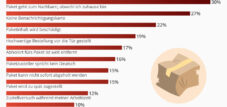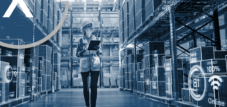Published on: May 1, 2025 / update from: May 1, 2025 - Author: Konrad Wolfenstein

The logistics challenges of the German rail network and solutions for the future-Image: Xpert.digital
Transport growth vs. Capacity limits: The stony path of Deutsche Bahn
Deutsche Bahn at the limit: How bottlenecks can be collected
The German rail network faces a fundamental dilemma: While transport demand is continuously increasing, the available infrastructure has shrunk significantly in recent decades. This discrepancy leads to considerable capacity bottlenecks and quality problems. The following report analyzes the current situation and presents concrete solutions that can contribute to a sustainable improvement in the German rail traffic system.
The problem of the shrinking rail network
Detail of the infrastructure with increasing demand
The rail network in Germany has experienced dramatic shrinkage since the rail reform in 1994. While the route length was still 44,600 kilometers in the railway reform year, it has now declined to around 39,200 kilometers. This reduction by about 5,400 kilometers corresponds to a decline of more than 12 percent. Most of the remaining network, around 33,400 kilometers, is currently operated by Deutsche Bahn (DB Infrago AG). If one looks at the so -called track length (i.e. the sum of all tracks, including multi -track routes), it reduced from 77,142 kilometers in 1994 to 60,999 kilometers at the end of 2022. This corresponds to a decline of almost 21 %.
This development appears particularly problematic against the background of the increased increased traffic demand. Traffic performance in rail goods transport has grown by almost 90 percent from 1994 to the present day. The transport performance in rail traffic in Germany was around 134 billion tons of kilometers in 2023. Traffic performance in rail traffic also increased by over 50 percent during the same period.
This opposite development - shrinking network with increasing demand - inevitably leads to an increased burden on the existing infrastructure. In the meantime, trains alone cover more than a billion kilometers on the DB Infrago route network.
Electrification and regional differences
The analysis of the rail infrastructure according to federal states shows significant regional differences. Of the total of 39,773 kilometers of operating length (as of December 31, 2020), only 21,100 kilometers are electrified, which corresponds to a share of around 53 percent. The city -states of Berlin (84%), Bremen (89%) and Hamburg (76%) have the highest levels of electrification. The Saarland leads among the area countries with 80 percent, while Schleswig-Holstein forms the bottom of only 27 percent.
With 6,638 kilometers, Bayern has the longest route network of all federal states, followed by North Rhine-Westphalia (5,516 km) and Lower Saxony (4,636 km). However, there are big differences in electrification: While 60 percent of the routes are electrified in North Rhine-Westphalia, this value in Bavaria is only 51 percent and even 44 percent in Lower Saxony.
Consequences of the network shrinkage
Capacity bottlenecks and overload
The combination of reduced network and increased traffic volume leads to considerable capacity bottlenecks. In 2022, the then DB Netz classified about 3,500 kilometers of the German rail network as high. According to forecasts, this high -loaded network will grow to around 9,000 kilometers by 2030. This corresponds to almost a quarter of the entire German rail network.
The capacity bottlenecks focus primarily on the main corridors and large nodes such as Cologne, Duisburg, Düsseldorf and Dortmund. There, all types of transport-rail passenger traffic, rail passenger traffic including S-Bahn and freight transport-have to use the same network. This mixed use also exacerbates the existing capacity problems.
Falling punctuality and quality of business
The overload of the infrastructure is clearly reflected in the punctuality statistics. In 2023, punctuality in the long -distance traffic of Deutsche Bahn was only 64 percent on average. The latest figures for 2024 even show a further decline at 62.5 percent. Trains that have exceeded their scheduled arrival time by less than six minutes are considered “operational on time”.
The tense situation is also noticeable in freight transport. The punctuality of DB Cargo in Germany was 70.5 percent in 2023, after 66.1 percent in 2022. The effects also show in the transport quantities: in 2023 the amount of goods traffic decreased by 6.1 percent in tons and 6.5 percent in tons of kilometers.
According to the Deutsche Bahn, punctuality is impaired by several factors: a partially overloaded rail network, disorders of the infrastructure, extensive construction work, the resulting capacity conflicts on the network as well as numerous external influences such as extreme weather events and dangerous interventions in rail traffic.
Solution approaches for a sustainable rail network
Stopping the dismantling and resuscitation of decommissioned routes
A fundamental measure to improve the situation is the immediate stop of other network reductions and the targeted reactivation of disabled routes. Germany has lost a significant part of its rail infrastructure since the rail reform in 1994. There were many supposedly good arguments to cut rails - above all the lack of demand on the affected routes - but it has now been recognized that the shrinking cure was a mistake.
The drastic decline in track connections is also particularly alarming. While there were still around 11,000 connections to the German rail network in 1997, in 2015 it was only about 3,250. This development complicates the direct access of companies to the rail network and contributes to the further shift of freight traffic onto the street.
The resuscitation of decommissioned routes could not only increase the capacity of the overall network, but also improve the resilience of the system by being available to alternative routes for diversions in the event of disorders or construction work.
Dual-use logistics: synergy between civil and military requirements
An innovative approach to increasing efficiency and sustainability lies in the concept of “dual-use” logistics, especially in combined traffic (KV) Schiene-Straße. This concept aims to use synergies between civilian economic interests and military defense requirements and to create a more resilient, more powerful transport infrastructure for both areas.
The “double” dual-use logistics (du logistics²) underlines two important dimensions of integration:
- The integration of the modes of transport: the use of combined traffic Schiene-Straße as the backbone of the system.
- The integration of users: the interpretation of the infrastructure and processes for efficient processing both civil and military logistics flows.
Several basic principles are important for successful implementation of this concept:
- Common use (shared use): infrastructures such as terminals, sections of the route and bridges are planned and built in such a way that they meet both civil and military requirements.
- Prioritization mechanism: clear rules for prioritizing military transports in times of crisis.
- Standardization: harmonization of technical standards for civil and military specifications.
- Resilience through design: infrastructure with high resistance to disorders and attacks.
- Integrated governance: close cooperation between military agencies, civilian authorities, infrastructure operators and private logistics companies.
When evaluating German KV terminals for their dual-use approval, there is a clear hierarchy: locations such as Duisburg and Hamburg stand out due to their high capacity, excellent rail connection and strategic importance. Other important nodes are Bremerhaven, Kornwestheim, Leipzig-Wahren and Cologne Eifeltor.
Suitable for:
- Du logistics² | Double dual-use logistics: integration of rail and street for civil and military purposes
GS1 Datamatrix: Optimization of logistics through digitization
Another promising approach to improve logistics is the use of the GS1 Datamatrix. This standardized 2D barcode with high data capacity and fault tolerance offers a robust method for the clear identification of components and to link digital data.
The integration of the GS1 Datamatrix in Telemainttenance processes significantly improves the data quality, accelerates diagnosis and repair processes and increases the surgical flexibility of maintenance. This leads to reduced downtime and potentially lower costs.
Suitable for:
- Future of maintenance logistics: Synergies between telemaintenance (remote maintenance) and GS1 Datamatrix
The technical properties of the GS1 Datamatrix make it particularly suitable for the requirements of modern defense logistics and maintenance:
- Comprehensive data coding: High data capacity for all relevant identification and attribute data.
- Direct parts marking (Direct Part Marking - DPM): Permanent marking even on small components.
- Robust and readability: reliable readability even under rough operating conditions.
- Standardization and interoperability: clear and consistent interpretation of the encoded data by various systems and organizations.
The combination of GS1 Datamatrix and Telemainttenance offers significant advantages over traditional methods, especially in automatic identification, data accuracy and data access.
Suitable for:
- Logistics transformation for safe shipping-as DataMatrix codes accelerate the general cargo handling-faster and more precisely
Intermodalverkehr: The example of Warsteiner
The Warsteiner Group offers a successful example of the use of intermodal transport. The company has been running its own container terminal at the Warstein production site since 2005, which also offers KV services for third parties.
Warsteiner focuses on punctuality in beer transport and reaches values of 99 percent, while Deutsche Bahn performs significantly worse with 62.5 percent in long -distance transport. The Logistics boss of Warsteiner, Daniel Küster, has doubled the freight volume within one year and shows that efficient intermodal concepts can be successfully implemented.
Suitable for:
Innovation in combined traffic
Digitization plays a key role in optimizing combined traffic. An important step in this direction is the establishment of DX Intermodal (DXI), a platform that is to combine all actors of the combined traffic for the first time. This company was founded by combined operators such as Hupac and combination traffic, transport companies such as Hoyer and Paneuropa, the railway company Lokomotion and the Ludwigshafen combination terminal.
The system is based on the EDIGE data exchange standard and enables access to timetables, bookings, terminal status, train journeys as well as progress and follow-up on the street. The data exchange takes place in real time and barrier -free, but always within a authorized distribution circle.
There are also important innovations in the area of vehicle technology. The VTG, a leading company in the area of wagon rental and rail freight transport, is driving various innovations, such as innovative freight cars, networked rail vehicles and foresighting maintenance and maintenance concepts.
Particularly noteworthy are the development of the modular modular system for the multifunctional freight car of the future "m²" and roadraillink technology (R2L), which makes non-compatible truck trailers crane. These innovations help to make rail freight transport more flexible and competitive.
Suitable for:
Rail network in upheaval: ways out of the capacity crisis - combined traffic as a gamechanger
The challenges of the German rail network are diverse and complex. The considerable decline in infrastructure with the same increasing traffic demand has caused serious capacity bottlenecks and quality problems. The falling punctuality and the declining goods traffic quantities are clear indicators of the critical situation.
However, the solutions presented offer reason to hope. Stopping the dismantling and the targeted reactivation of disabled routes can increase the capacity of the overall network. The concept of dual -use logistics promises synergies between civil and military requirements. The use of innovative technologies such as the GS1 Datamatrix can significantly improve the efficiency and reliability of logistics. Successful examples like Warsteiner show that intermodal concepts can work in practice. And last but not least, innovations in combined traffic help to make rail freight transport sustainable.
In order to exploit the full potential of rail transport, however, a holistic approach is required that integrates all of these aspects and aims at sustainable, efficient and resilient transport infrastructure. This is the only way to do justice to the rail of its role as an environmentally friendly and efficient mode of transport and make a significant contribution to achieving climate and traffic goals.
Suitable for:
Advice - planning - implementation
I would be happy to serve as your personal advisor.
Head of Business Development
Chairman SME Connect Defense Working Group
Advice - planning - implementation
I would be happy to serve as your personal advisor.
contact me under Wolfenstein ∂ Xpert.digital
call me under +49 89 674 804 (Munich)


















